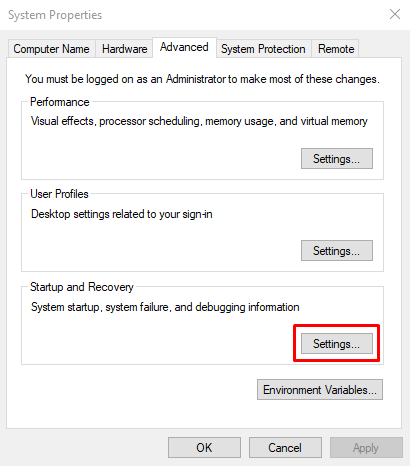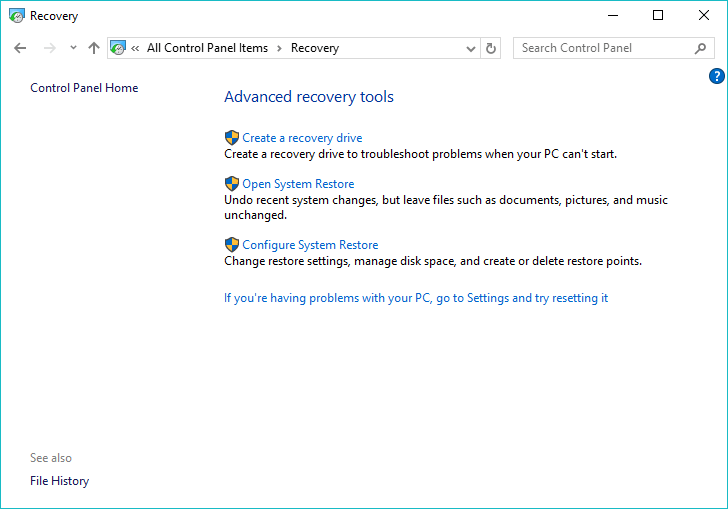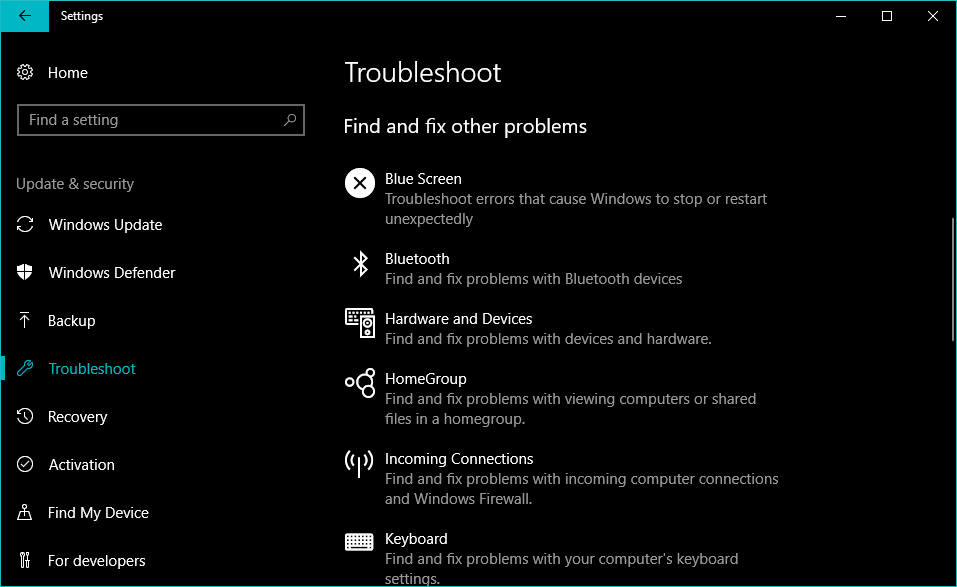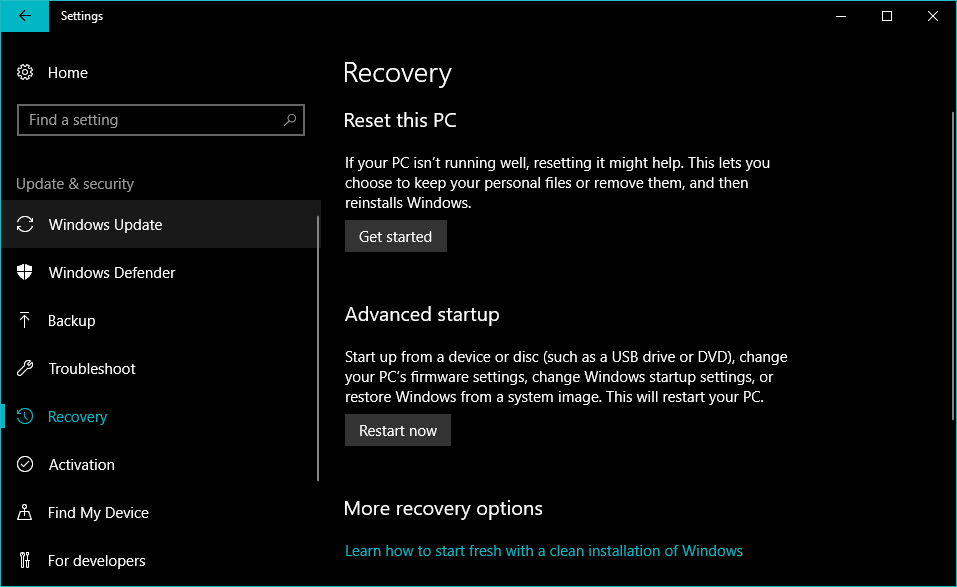Now, what if you encounter a BSOD on your computer? How to get rid of
the STOP error? There are a few ways to fix blue screen in Windows 10
that haunts people every now then.
Things to do first – Repair Blue Screen
Disable automatic restart
In
most cases, Windows 10 is configured by default to restart
automatically when the STOP error occurs. In that situation, you don’t
get enough time to note down the error code related to the BSOD. So, to
initiate your process of fixing Windows 10 blue screen error, you need
to hold the STOP error screen for some time. Here is how to do that:
- Right-click This PC.
- Go to Properties.
- On the left-hand side, click Advanced System Settings.
- Under Startup and Recovery, click Settings.

- Now, under System Failure, untick the checkbox that says Automatically restart.

- Click Ok to save and continue.
Check for Viruses
One
of the causes of BSOD showing upon your Windows 10 PC is data
corruption. Other than regular scenarios, the data on your computer
might get corrupt due to some malware.
So, if you experience blue screen in Windows 10 more than what you can call usual, you should use some
antivirus software
to do a full scan of your system. Windows Defender, the default
antivirus in Windows 10 can also be a good option to scan your system
and repair blue screen.
Next, comes Windows Update
You
should make sure that your PC is regularly updated with latest security
patches and other updates. This is one of the essential things in order
to fix blue screen errors or even prevent them from appearing in the
first place. Users running Windows 10 don’t need to do much as updates
install automatically and there is only a little
you can do to stop them.
Update the hardware drivers and firmware
Faulty
drivers on your PC can cause the blue screen of death to appear on your
computer screen. So, updating or repairing them would also help you get
rid of the BSOD devil.
Universal Windows drivers take care of
most the hardware nowadays. But still, it isn’t all-inclusive. For the
drivers that Windows can’t update automatically, you need to do it
manually by downloading them from the manufacturer’s website.
Also,
you should keep the firmware of your computer, i.e., BIOS or UEFI to
its latest version. Don’t forget to check whether the hardware
components on your system are facing increased heat levels. You can use
some software like
Piriform’s Speccy.
Higher
temperatures might be due to dust clogging up the fan. To prevent this,
you should clean your machine regularly. Also, you should remove
external non-essential hardware such as USB storage drives, printers,
gamepads, etc. to see if they’re causing BSOD. Read our guide to
preventing a computer from overheating.
How to Fix Blue Screen of Death in Windows 10
Boot to Safe Mode
For
years, Windows users have used Safe Mode to find the cause of various
problems that exists on their computers. And the blue screen of death is
no exception. You can fix blue screen errors in Windows 10 or older
versions using the Safe Mode.
When you boot to Safe Mode in
Windows, only the essential Windows services, and drivers load. If you
don’t see any BSOD, then you can accuse some third-party driver
of putting the BSOD on your computer.
How to use safe mode in Windows?
Earlier, in the case of Windows XP and 7, you could use the
msconfig
utility to boot into safe mode or press the F8 key when you start the
machine. Windows 10 has added another more comfortable option to access
the Safe Mode.
- Go to Settings > Update & Recovery > Recovery.
- Under Advanced Startup, click Restart Now. Wait for the Advanced Startup options screen to appear.
- Click Troubleshoot.
- On the next screen, click Startup Settings. Click Restart to boot to Safe Mode.
Use system restore
By
including System Restore in Windows, Microsoft has given a way to undo
your sins. It can help if the blue screen of death is occurred
because of some software or driver you recently installed.

You
can find various settings related to Windows 10 System Restore in
Control Panel > Recovery. To rollback Windows to an earlier point in
time, click Open System Restore and follow the steps. To add a restore
point, click Configure System Restore > Create. Chances are high that
the blue screen will get fixed if it’s due some recent change on your
computer.
Windows 10 blue screen Troubleshooter to repair blue screen
If
you are running the Creators Update or later, Microsoft has got you
covered in case a Windows 10 BSOD occurs. You can fix the blue screen of
the death using the built-in troubleshooter. Go to Settings > Update
and security > Troubleshoot.

Under the heading Find and fix other problems, you can see the Windows 10 Blue Screen troubleshooter.
Delete the faulty Windows update
It’s
not uncommon for Windows Update to break during installation. And such
incidents can cause the blue screen to appear. The easiest way to fix
Windows 10 blue screen would be uninstalling the faulty update. Similar
would be the case of some app which might have corrupt important files
on your Windows PC.
You can remove Windows Update by visiting
Settings > Update & Recovery > Windows Update > Update history > Unistall updates.
Reinstall Windows to fix blue screen of death

Clearly, the last resort to kick the blue screen of death off your system is to perform a
clean install of the Windows.
For users running Windows 10 or 8.1, there is a built-in option for
clean installation which doesn’t require you have a dedicated
installation media. For Windows 7, you’ll have to reinstall the
operating system using a
bootable USB or optical disk.
If
it’s not some hardware related issue, then you should be able to fix
Windows 10 BSOD error using the methods and tips mentioned above.
Otherwise, you’ll have to approach some store for the replacement
hardware to get things done.
How is your experience with BSODs so far? Drop your thoughts in the comments.






Comments
Post a Comment